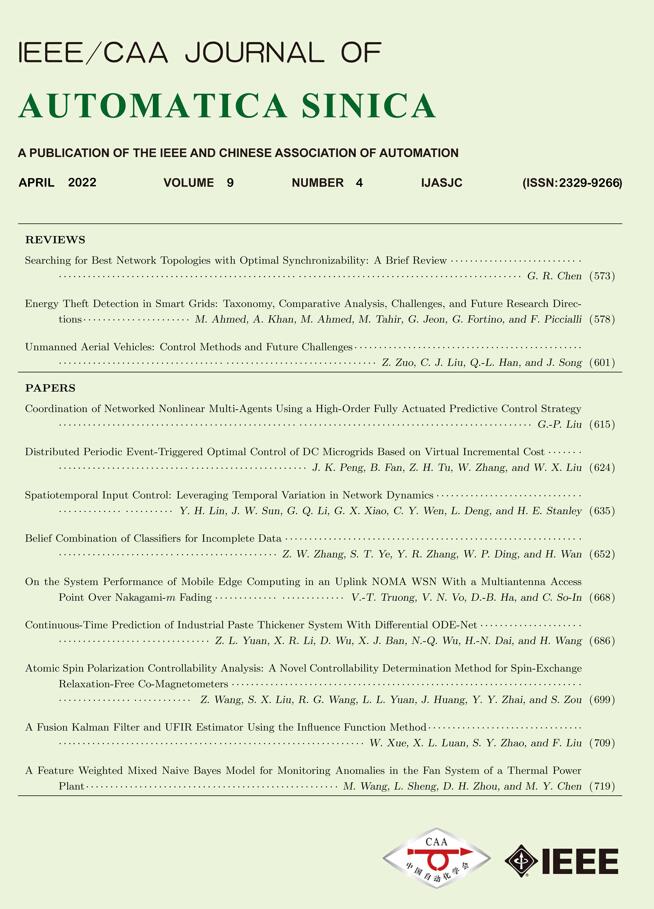 Volume 9
Issue 4
Volume 9
Issue 4
IEEE/CAA Journal of Automatica Sinica
| Citation: | G.-P. Liu, “Coordination of networked nonlinear multi-agents using a high-order fully actuated predictive control strategy,” IEEE/CAA J. Autom. Sinica, vol. 9, no. 4, pp. 615–623, Apr. 2022. doi: 10.1109/JAS.2022.105449 |

| [1] |
F. Chen and W. Ren, On the Control of Multi-Agent Systems: A Survey, Publisher: now, 2019.
|
| [2] |
P. Shi and B. Yan, “A Survey on intelligent control for multiagent systems,” IEEE Trans. Systems, Man, and Cybernetics: Systems, vol. 51, no.1, pp.161–175, 2021.
|
| [3] |
T. Meng, Z. Lin, and Y. A. Shamash, “Distributed cooperative control of battery energy storage systems in DC microgrids,” IEEE/CAA Journal of Automatica Sinica, vol. 8, no. 3, pp. 606–616, 2021. doi: 10.1109/JAS.2021.1003874
|
| [4] |
H. Hong, W. Yu, J. Fu, and X. Yu, “Finite-time connectivity-preserving consensus for second-order nonlinear multiagent systems,” IEEE Trans. Control of Network Systems, vol. 6, no. 1, pp. 236–248, 2019. doi: 10.1109/TCNS.2018.2808599
|
| [5] |
X.M. Zhang, Q.L. Han, X. Ge, D. Ding, L. Ding, D. Yue, and C. Peng, “Networked control systems: A survey of trends and techniques,” IEEE/CAA Journal of Automatica Sinica, vol. 7, no. 1, pp. 1–17, 2020. doi: 10.1109/JAS.2019.1911861
|
| [6] |
Z. Wang, M. He, T. Zheng, Z. Fan, and G. Liu, “Guaranteed cost consensus for high-dimensional multi-agent systems with time-varying delays,” IEEE/CAA Journal of Automatica Sinica, vol. 5, no. 1, pp. 181–189, 2018. doi: 10.1109/JAS.2017.7510430
|
| [7] |
X. Jiang, G. Xia, Z. Feng, and Z. Jiang, “Consensus tracking of data-sampled nonlinear multi-agent systems with packet loss and communication delay,” IEEE Trans. Network Science and Engineering, vol. 8, no. 1, pp. 126–137, 2021. doi: 10.1109/TNSE.2020.3029972
|
| [8] |
H. J. Savino, C. R. P. dos Santos, F. O. Souza, L. C. A. Pimenta, M. de Oliveira, and R. M. Palhares, “Conditions for consensus of multi-agent systems with time-delays and uncertain switching topology,” IEEE Trans. Industrial Electronics, vol. 63, no. 2, pp. 1258–1267, 2016. doi: 10.1109/TIE.2015.2504043
|
| [9] |
A. Nandanwar, N. K. Dhar, D. Malyshev, L. Rybak and L. Behera, “Stochastic event-based super-twisting formation control for multi-agent system under network uncertainties,” IEEE Trans. Control of Network Systems, to be published,
|
| [10] |
X. Ge, Q.-L. Han, L. Ding, Y. L. Wang, and X. M. Zhang, “Dynamic event-triggered distributed coordination control and its applications: A survey of trends and techniques,” IEEE Trans. Systems,Man,and Cybernetics:Systems, vol. 50, no. 9, pp. 3112–3125, 2020. doi: 10.1109/TSMC.2020.3010825
|
| [11] |
D. V. Dimarogonas, E. Frazzoli, and K. H. Johansson, “Distributed event-triggered control for multi-agent systems,” IEEE Trans. Automatic Control, vol. 57, no. 5, pp. 1291–1297, 2011.
|
| [12] |
W. Chen, D. Ding, X. Ge, Q.-L. Han, and G. Wei, “H∞ containment control of multiagent systems under event-triggered communication scheduling: The finite-horizon case,” IEEE Trans. Cybernetics, vol. 50, no. 4, pp. 1372–1382, 2020. doi: 10.1109/TCYB.2018.2885567
|
| [13] |
G. P. Liu, “Predictive controller design of networked systems with communication delays and data loss,” IEEE Trans. Circuits and Systems II, vol. 57, no. 6, pp. 481–485, 2010. doi: 10.1109/TCSII.2010.2048377
|
| [14] |
C. Tan and G. P. Liu, “Consensus of discrete-time linear networked multi-agent systems with communication delays,” IEEE Trans. Automatic Control, vol. 58, no. 11, pp. 2962–2968, 2013. doi: 10.1109/TAC.2013.2261177
|
| [15] |
G. P. Liu, “Consensus and stability analysis of networked multi-agent predictive control,” IEEE Trans. Cybernetics, vol. 47, no. 4, pp. 1114–1119, 2017. doi: 10.1109/TCYB.2016.2535126
|
| [16] |
G. P. Liu, “Predictive control of networked multi-agent systems via cloud computing,” IEEE Trans. Cybernetics, vol. 47, no. 8, pp. 1852–1859, 2017. doi: 10.1109/TCYB.2017.2647820
|
| [17] |
J. Ni, P. Shi, Y. Zhao, and Z. Wu, “Fixed-time output consensus tracking for high-order multi-agent systems with directed network topology and packet dropout,” IEEE/CAA Journal of Automatica Sinica, vol. 8, no. 4, pp. 817–836, 2021. doi: 10.1109/JAS.2021.1003916
|
| [18] |
Q. Liu, “Pseudo-predictor feedback control for multiagent systems with both state and input delays,” IEEE/CAA Journal of Automatica Sinica, vol. 8, no. 11, pp. 1827–1836, 2021. doi: 10.1109/JAS.2021.1004180
|
| [19] |
D. H. Nguyen, “Minimum-rank dynamic output consensus design for heterogeneous nonlinear multi-agent systems,” IEEE Trans. Control of Network Systems, vol. 5, no. 1, pp. 105–115, 2018. doi: 10.1109/TCNS.2016.2580908
|
| [20] |
C. L. P. Chen, G. X. Wen, and Y. J. Liu, “Observer-based adaptive backstepping consensus tracking control for high-order nonlinear semi-strict-feedback multiagent systems,” IEEE Trans. Cybernetics, vol. 46, no. 7, pp. 1591–1601, 2016. doi: 10.1109/TCYB.2015.2452217
|
| [21] |
H. Hong, W. Yu, J. Fu, and X. Yu, “A novel class of distributed fixed-time consensus protocols for second-order nonlinear and disturbed multi-agent systems,” IEEE Trans. Network Science and Engineering, vol. 6, no. 4, pp. 760–772, 2019. doi: 10.1109/TNSE.2018.2873060
|
| [22] |
B. Ning, Q.-L. Han, and L. Ding, “Distributed secondary control of AC microgrids with external disturbances and directed communication topologies: A full-order sliding-mode approach,” IEEE/CAA Journal of Automatica Sinica, vol. 8, no. 3, pp. 554–564, 2021. doi: 10.1109/JAS.2020.1003315
|
| [23] |
C. Zhang, L. Chang, and X. Zhang, “Leader-follower consensus of upper-triangular nonlinear multi-agent systems,” IEEE/CAA Journal of Automatica Sinica, vol. 1, no. 2, pp. 210–217, 2014. doi: 10.1109/JAS.2014.7004552
|
| [24] |
G.R. Duan, “High-order fully actuated system approaches – Part I: Models and basic procedure,” Int. Journal of Systems Sciences, vol. 52, no. 2, pp. 422–435, 2021. doi: 10.1080/00207721.2020.1829167
|